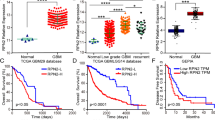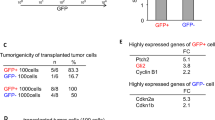Abstract
Glioblastoma is the most common malignant tumor in the central nervous system. The general transcription factor IIE subunit beta (GTF2E2) is crucial for physiological and pathological functions, but its roles in the malignant biological function of glioma remain ambiguous. CCK-8, colony formation assays, TUNEL assays, cell migration assays, wound-healing assays, and xenograft model were established to investigate the biological functions of GTF2E2 both in vitro and in vivo. GTF2E2 was overexpressed in glioma and was associated with poor prognosis of glioma patients. Biological functions of GTF2E2 were investigated both in vitro and in vi0vo by multiple experiments. Moreover, we explored the possible mechanisms of GTF2E2. In our results, we demonstrated that GTF2E2 could be regulated by miR-340-5p directly or indirectly. CCND1 was transcriptionally affected by GTF2E2 and glioma progression was then regulated. Our data presented the overexpression of GTF2E2 in glioma and indicated the association between GTF2E2 and glioma prognosis. GTF2E2 was found to be regulated by miR-340-5p and thus affect downstream gene expressions and glioma progression. Our results indicate that GTF2E2 might be a potential target in the diagnosis and treatments of glioblastoma.
This is a preview of subscription content, access via your institution
Access options
Subscribe to this journal
Receive 12 print issues and online access
269,00 € per year
only 22,42 € per issue
Buy this article
- Purchase on SpringerLink
- Instant access to full article PDF
Prices may be subject to local taxes which are calculated during checkout








Similar content being viewed by others
Data availability
The datasets used and/or analyzed during the current study are available from the corresponding author on reasonable request.
References
Figarella-Branger D, Appay R, Metais A, Tauziède-Espariat A, Colin C, Rousseau A, et al. [The 2021 WHO classification of tumours of the central nervous system]. Ann Pathol. 2021;42:367–82.
Lee E, Yong RL, Paddison P, Zhu J. Comparison of glioblastoma (GBM) molecular classification methods. Semin Cancer Biol. 2018;53:201–11.
Wu W, Klockow JL, Zhang M, Lafortune F, Chang E, Jin L, et al. Glioblastoma multiforme (GBM): an overview of current therapies and mechanisms of resistance. Pharmacol Res. 2021;171:105780.
Hervey-Jumper SL, Berger MS. Maximizing safe resection of low- and high-grade glioma. J Neurooncol. 2016;130:269–82.
D’Amico RS, Englander ZK, Canoll P, Bruce JN. Extent of resection in glioma-a review of the cutting edge. World Neurosurg. 2017;103:538–49.
Kuschal C, Botta E, Orioli D, Digiovanna JJ, Seneca S, Keymolen K, et al. GTF2E2 mutations destabilize the general transcription factor complex TFIIE in individuals with DNA repair-proficient trichothiodystrophy. Am J Hum Genet. 2016;98:627–42.
Miwa K, Kojima R, Obita T, Ohkuma Y, Tamura Y, Mizuguchi M. Crystal structure of human general transcription factor TFIIE at atomic resolution. J Mol Biol. 2016;428:4258–66.
Yang L, Zeng W, Sun H, Huang F, Yang C, Cai X, et al. Bioinformatical analysis of Gene Expression Omnibus Database associates TAF7/CCNB1, TAF7/CCNA2, and GTF2E2/CDC20 pathways with glioblastoma development and prognosis. World Neurosurg. 2020;138:e492–514.
Bi G, Zhu D, Bian Y, Huang Y, Zhan C, Yang Y, et al. Knockdown of GTF2E2 inhibits the growth and progression of lung adenocarcinoma via RPS4X in vitro and in vivo. Cancer Cell Int. 2021;21:181.
Zhang Y, Zhang Y, Ai B, Gong J, Li Y, Yu S, et al. GTF2E2 is a novel biomarker for recurrence after surgery and promotes progression of esophageal squamous cell carcinoma via miR-139-5p/GTF2E2/FUS axis. Oncogene. 2022;41:782–96.
Bartel DP. Metazoan microRNAs. Cell. 2018;173:20–51.
Lu TX, Rothenberg ME. MicroRNA. J Allergy Clin Immunol. 2018;141:1202–7.
Fabian MR, Sonenberg N. The mechanics of miRNA-mediated gene silencing: a look under the hood of miRISC. Nat Struct Mol Biol. 2012;19:586–93.
Zhang Z, Li J, Huang Y, Peng W, Qian W, Gu J, et al. Upregulated miR-1258 regulates cell cycle and inhibits cell proliferation by directly targeting E2F8 in CRC. Cell Prolif. 2018;51:e12505.
Sati I, Parhar I. MicroRNAs regulate cell cycle and cell death pathways in glioblastoma. Int J Mol Sci. 2021;22:13550.
Qie S, Diehl JA. Cyclin D1, cancer progression, and opportunities in cancer treatment. J Mol Med. 2016;94:1313–26.
Sun T, Xu YJ, Jiang SY, Xu Z, Cao BY, Sethi G, et al. Suppression of the USP10/CCND1 axis induces glioblastoma cell apoptosis. Acta Pharmacol Sin. 2021;42:1338–46.
Pavlyukov MS, Yu H, Bastola S, Minata M, Shender VO, Lee Y, et al. Apoptotic cell-derived extracellular vesicles promote malignancy of glioblastoma via intercellular transfer of splicing factors. Cancer Cell. 2018;34:119.e10–35.e10.
Mahzouni P, Taheri F. An immunohistochemical study of cyclin D1 expression in astrocytic tumors and its correlation with tumor grade. Iran J Pathol. 2019;14:252–7.
Nicholson JG, Fine HA. Diffuse glioma heterogeneity and its therapeutic implications. Cancer Discov. 2021;11:575–90.
Darmanis S, Sloan SA, Croote D, Mignardi M, Chernikova S, Samghababi P, et al. Single-cell RNA-seq analysis of infiltrating neoplastic cells at the migrating front of human glioblastoma. Cell Rep. 2017;21:1399–410.
Zhao L, Wen ZH, Jia CH, Li M, Luo SQ, Bai XC. Metformin induces G1 cell cycle arrest and inhibits cell proliferation in nasopharyngeal carcinoma cells. Anat Rec. 2011;294:1337–43.
Peixoto C, Martins M, Costa L, Vinga S. Kidney cancer biomarker selection using regularized survival models. Cells. 2022;11:2311.
Zhong X, Cai Y. Long non-coding RNA (lncRNA) HOXD-AS2 promotes glioblastoma cell proliferation, migration and invasion by regulating the miR-3681-5p/MALT1 signaling pathway. Bioengineered. 2021;12:9113–27.
Tufano M, D’Arrigo P, D’Agostino M, Giordano C, Marrone L, Cesaro E, et al. PD-L1 expression fluctuates concurrently with cyclin D in glioblastoma cells. Cells. 2021;10:2366.
Jaiswal M, Tripathi A, Singh D, Kumar A, Singh M, Batra N, et al. Clinical correlation and role of cyclin D1 expression in glioblastoma patients: a study from North India. Cureus. 2022;14:e22346.
Hamada T, Akahane T, Yokoyama S, Higa N, Kirishima M, Matsuo K, et al. An oncogenic splice variant of PDGFRα in adult glioblastoma as a therapeutic target for selective CDK4/6 inhibitors. Sci Rep. 2022;12:1275.
Bai Q, Li Y, Song K, Huang J, Qin L. Knockdown of XIST up-regulates 263294miR-340-5p to relieve myocardial ischaemia-reperfusion injury via inhibiting cyclin D1. ESC Heart Fail. 2022;9:1050–60.
Li Z, Wong KY, Calin GA, Chng WJ, Chan GC, Chim CS. Epigenetic silencing of miR-340-5p in multiple myeloma: mechanisms and prognostic impact. Clin Epigenetics. 2019;11:71.
Li Q, Hagberg CE, Silva Cascales H, Lang S, Hyvönen MT, Salehzadeh F, et al. Obesity and hyperinsulinemia drive adipocytes to activate a cell cycle program and senesce. Nat Med. 2021;27:1941–53.
Wu Y, Zheng Q, Li Y, Wang G, Gao S, Zhang X, et al. Metformin targets a YAP1-TEAD4 complex via AMPKα to regulate CCNE1/2 in bladder cancer cells. J Exp Clin Cancer Res. 2019;38:376.
Yenmiş G, Beşli N, Yaprak Saraç E, Hocaoğlu Emre FS, Şenol K, Kanıgür G. Metformin promotes apoptosis in primary breast cancer cells by downregulation of cyclin D1 and upregulation of P53 through an AMPK-alpha independent mechanism. Turk J Med Sci. 2021;51:826–34.
Yudhani RD, Astuti I, Mustofa M, Indarto D, Muthmainah M. Metformin modulates cyclin D1 and P53 expression to inhibit cell proliferation and to induce apoptosis in cervical cancer cell lines. Asian Pac J Cancer Prev. 2019;20:1667–73.
Liu M, Zhang Z, Wang H, Chen X, Jin C. Activation of AMPK by metformin promotes renal cancer cell proliferation under glucose deprivation through its interaction with PKM2. Int J Biol Sci. 2019;15:617–27.
Uddin MS, Mamun AA, Alghamdi BS, Tewari D, Jeandet P, Sarwar MS, et al. Epigenetics of glioblastoma multiforme: from molecular mechanisms to therapeutic approaches. Semin Cancer Biol. 2022;83:100–20.
Kunadis E, Lakiotaki E, Korkolopoulou P, Piperi C. Targeting post-translational histone modifying enzymes in glioblastoma. Pharmacol Ther. 2021;220:107721.
Demircan T, Yavuz M, Kaya E, Akgül S, Altuntaş E. Cellular and molecular comparison of glioblastoma multiform cell lines. Cureus. 2021;13:e16043.
Zhou Q, Liu J, Quan J, Liu W, Tan H, Li W. MicroRNAs as potential biomarkers for the diagnosis of glioma: a systematic review and meta-analysis. Cancer Sci. 2018;109:2651–9.
Nan Y, Guo L, Zhen Y, Wang L, Ren B, Chen X, et al. miRNA-451 regulates the NF-κB signaling pathway by targeting IKKβ to inhibit glioma cell growth. Cell Cycle. 2021;20:1967–77.
Ivanov YD, Malsagova KA, Popov VP, Pleshakova TO, Kozlov AF, Galiullin RA, et al. Nanoribbon-based electronic detection of a glioma-associated circular miRNA. Biosensors. 2021;11:237.
Zheng Y, Zhao P, Lian Y, Li S, Chen Y, Li L. MiR-340-5p alleviates oxygen-glucose deprivation/reoxygenation-induced neuronal injury via PI3K/Akt activation by targeting PDCD4. Neurochem Int. 2020;134:104650.
Zhang L, Kang W, Lu X, Ma S, Dong L, Zou B. LncRNA CASC11 promoted gastric cancer cell proliferation, migration and invasion in vitro by regulating cell cycle pathway. Cell Cycle. 2018;17:1886–900.
Wu X, Kong C, Wu Y. Long intergenic non-protein coding RNA 1094 (LINC01094) promotes the progression of breast cancer (BC) by regulating the microRNA-340-5p (miR-340-5p)/E2F transcription factor 3 (E2F3) axis. Bioengineered. 2021;12:9046–57.
Acknowledgements
This work was supported by the Natural Science Foundation of Anhui Province [grant number 2108085MH296], the Open Research Fund of Anhui Province Key Laboratory of High Field Magnetic Resonance Imaging [grant number KFKT-2020-0002], the Joint Fund for Medical Artificial Intelligence [grant number MAI2022Q011], and the Science and Technology Project grant from Anhui Province [grant number 202004j07020021].
Author information
Authors and Affiliations
Contributions
CC, YJ, and CN designed this project. XQ and ZW performed the experiments. NP, WN, and JW collected specimen. XQ and YC analyzed the data and wrote the paper. All authors have discussed the results and made comments on the experiment.
Corresponding authors
Ethics declarations
Competing interests
The authors declare no competing interests.
Ethics approval and consent to participate
All procedures involving human participants in this study were approved by the Research Ethics Committee of the First Affiliated Hospital of USTC. All patients included in the present study signed informed consent. All animal experiments were approved by the Animal Management Committee of the First Affiliated Hospital of USTC.
Additional information
Publisher’s note Springer Nature remains neutral with regard to jurisdictional claims in published maps and institutional affiliations.
Rights and permissions
Springer Nature or its licensor (e.g. a society or other partner) holds exclusive rights to this article under a publishing agreement with the author(s) or other rightsholder(s); author self-archiving of the accepted manuscript version of this article is solely governed by the terms of such publishing agreement and applicable law.
About this article
Cite this article
Qiao, X., Chen, Y., Wang, Z. et al. GTF2E2 downregulated by miR-340-5p inhibits the malignant progression of glioblastoma. Cancer Gene Ther 30, 1702–1714 (2023). https://doi.org/10.1038/s41417-023-00676-1
Received:
Revised:
Accepted:
Published:
Issue Date:
DOI: https://doi.org/10.1038/s41417-023-00676-1
This article is cited by
-
Etomidate suppresses proliferation, migration, invasion, and glycolysis in esophageal cancer cells via PI3K/AKT pathway inhibition
Cytotechnology (2025)
-
Improving prediction performance of general protein language model by ___domain-adaptive pretraining on DNA-binding protein
Nature Communications (2024)
-
Combined metformin and simvastatin therapy inhibits SREBP2 maturation and alters energy metabolism in glioma
Cell Death & Disease (2024)
-
Evaluation of Xihuang Pill in inducing pyroptosis in glioma cells through modulation of miR-21-5p
3 Biotech (2024)



